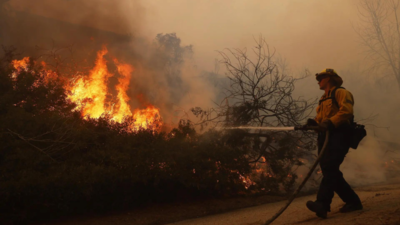Two massive wildfires broke out in Los Angeles on Tuesday, causing destruction and chaos. Fires ripped through Pacific Palisades and Eaton Canyon in Altadena, destroying homes, prompting evacuations and disrupting the lives of thousands of residents.
In Pacific Palisades, the fire started around 10:30 a.m. and quickly spread, burning 4.6 square miles. Thick smoke was visible across the city, and some residents in Venice Beach, 10 kilometers away, reported flames on the horizon. Evacuation orders were issued as major roadways, including portions of Interstate 10 and the Pacific Coast Highway, were closed to all non-essential vehicles.
Meanwhile, the Altadena Fire ignited near the Eaton Canyon Natural Area around 6:30 p.m. The fire spread quickly, covering an area of 400 acres, forcing evacuations in several communities, including Kinneloa Canyon and Outpost Lane. Residents and hikers fled as the fires turned the sky orange and filled the air with thick smoke.
What was the cause of the fire?
Historically, California has had many wildfires, with the number doubling in recent years.
Like much of the West, California typically receives most of its moisture in the fall and winter. As a result, summer vegetation remains dry due to low rainfall and warm temperatures, creating conditions for wildfires. However, with global warming, temperatures have increased by 1-2 degrees Celsius, leading to an increase in wildfire events.
Southern California has faced dry and windy conditions with very little rainfall since early May. The combination of notorious Santa Ana winds and above-average temperatures creates highly flammable conditions that make the area prone to wildfires.
Santa Ana winds are dry, warm (usually hot) winds that blow westward from inland areas toward the Southern California coast. These winds are usually seasonal, occurring between October and March, with a peak in December.
this National Weather Service Winds may increase overnight, with gusts of up to 100 mph (160 kph) expected in mountainous and foothill areas, the warning said. These conditions continue to pose serious challenges to firefighting efforts and may lead to further fire spread.
What is the impact of wildfires?
this Los Angeles wildfires The blaze sparked widespread panic and forced thousands of people to evacuate as it threatened thousands of buildings.
Residents were trapped in traffic jams, with some abandoning their cars and fleeing on foot. Major roads were closed and power outages affected people.
Strong winds exacerbate fire risks, drying out vegetation quickly and complicating firefighting efforts.
The situation was chaotic and bulldozers cleared abandoned vehicles to allow emergency teams to gain access. As the fires continue to spread, authorities are grappling with the crisis while residents remain on edge due to the ongoing threat posed by strong winds and dry weather.








